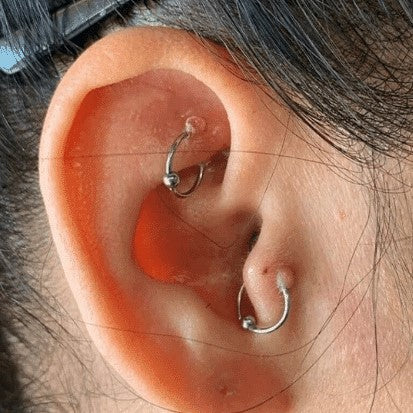
How to treat piercing bumps
Share
How to treat piercing bumps
The piercing bumps are small or medium-sized fleshy balls that form at the piercing site on the inner surface of the ear or on the outer surface.
There are two types:
Type 1: red bumps (usually without inflammation or pus) These bumps are formed as a result of the immune system mistakenly fighting healthy bodies suspected of being pathogenic, such as bacteria and viruses. It is usually painless, but it has an annoying appearance.
Type 2: bumps with inflammation and pus that is painful and causes ulceration and swelling. Bumps occur as a result of the body's reaction to the puncture, which is a very normal and common occurrence. The ear naturally secretes collagen, but with the presence of the piercing, especially in the first months, the ear will continue to secrete collagen, but it will be deposited through the hole to the outside of the ear, which makes collagen secration gather on the piercing surface and formes a bump

Common symptoms:
- Redness of the piercing site
- Intense itching at the site of the piercing
- Inflammation and swelling
- Pain (in case of inflammation)
Factors that contribute to the formation of bumps:
- First: pressure on the piercing site. Pressure is the common and main cause, and it often occurs at bedtime. The ear should not be subjected to any kind of pressure, and sleep on the Piercing site should be avoided for at least two months. Headphones should not be worn for a long time. Heavy earring should not be worn.
- Second: Use of a non-medical earring. Titanium and nickel-free stainless steel rings must be used. The use of any other type of metal may lead to an allergic reaction.
- Third: Piercing size. You must choose a suitable earring size. It should be long to give the ear space to heal. Avoid wearing narrow earring because it creates friction.
- Fourth: Wrong Behaviors:
- Touching the piercing with the fingers. The piercing must not be touched at all, because it will spread bacteria.
- you should avoid Showering and exposig the piercing to water during the first 3 days after having your ears pierced.
- don't Self-pierce at home. using thye self piercing tools sold online creates problems and causes inflemation. piercings must be done by a proffesional piercer.
Treatment:
- The ear should not be subjected to any kind of pressure.DO NOT sleep on the piercing area for at least 3 mounths .
- Make sure to choose a medical earring with an appropriate size.
- Use saline solution or water for cleaning and disinfection twice a day.
- If there is inflammation, I recommend using Fucidin cream twice a day for two weeks.
- Never touch the piercing with your fingers, don't play and move the piercing.
- Disc installation. It is a small piece of silicone that is placed on each side of the piercing, which helps in reducing pressure on the piercing site and thus removes and heals the bump in a period of 3 to 4 weeks.
Note: there is differance between Piercing Bumps and keloid

